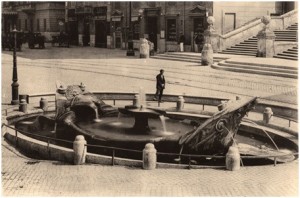Rome is the city of light, certainly, but it is also the city of water. Tourists may visit for the city’s celebrated history and architecture, but they leave entranced by the babbling fountains which dot the city like stars. What most don’t realize is that most of those fountains were designed by the same man: the astoundingly talented Gian Lorenzo Bernini.
Immortalized in countless great works of cinema, from Frederico Felini’s La Dolce Vita to Woody Allen’s To Rome With Love, Bernini’s fountains are essential to the character of this most romantic of cities. His Fontana della Barcaccia on the Spanish Steps even provided the backdrop for Gregory Peck and Audry Hepburn to meet cute in Roman Holiday, and has been photographed by countless tourists attempting capture a uniquely Italian image. In many ways, modern Rome is the city Bernini built.
Still, as influential as he is today, Bernini’s path to artistic immortality was not smooth. In the seventeenth century when he was a young man he was quite a controversial figure, his artistic genius at times overshadowed by the scandals that surrounded him.

Gian Lorenzo Bernini, Self-Portrait as a Young Man. c. 1623. Oil on canvas, 62×46 cm. Galleria Borghese, Rome, Italy
Bernini was the darling of the art world from the age of eight, when Pope Paul V boasted that the child would be “The Michelangelo of his century.” And as he grew up, and his skills increased, so did his social success. Beloved by the wealthiest families in Italy, and a favourite of the church, Bernini led a charmed life. At least, until he met Constanza Buanerelli.
Constanza was the wife of Bernini’s assistant Matteo, a young and lovely woman whose freshness and charm immediately won over the artist. He was inspired by her sensuality, and she quickly became his muse, her post-coital rumple immortalized in stone in one of his most celebrated busts.

Gian Lorenzo Bernini, Bust of Constanza Buonarelli. c. 1635. Marble, 72 cm. Museo Nazionale del Bargello, Florence, Italy
Alas, their happiness was brief. Bernini was an extremely jealous lover, infuriated that he was forced to share Constanza with her husband. He repeatedly insulted the hapless Matteo to such a great extent that his affair with Constanza became a matter of common knowledge, and she was jailed for adultery. Protected by his powerful friends, Bernini himself got off scot free.
Constanza, tired of her lover’s covetousness, took her revenge by beginning an affair with his brother. Enraged, Bernini followed the pair to the steps of St. Peter’s basilica, the Pope’s seat of power, whose interior he had so masterfully designed years before. He beat his brother half to death with an iron rod, and bribed a servant to slash Constanza’s face with a razor, destroying the beauty that had once captivated him.
Pope Urban VIII used his power to get Bernini out of trouble, even excusing the 3000 scudi fee the court leveled against him. But the pope was tired of helping the bad boy artist out of romantic scrapes, and this time his help came with a price. He forced Bernini to marry a virtuous woman of the church’s choosing, a union that was by all accounts a happy one, lasting decades and producing eleven children.
Still, Bernini never sculpted his wife. Maybe he had learned his lesson with Constanza, his great love and his muse, whose faithless beauty he so fatally immortalized.
Those of you lucky enough to be in New York should make sure to check out Bernini: Sculpting in Clay at the world famous Metropolitan Museum of Art from October 3, 2012 to January 6, 2013. Or to follow along at home, and get critical insight into Bernini’s controversial life and work, check out our ebooks on Sculpture and Baroque Art, both written by celebrated art historian Victoria Charles.
-George Kostrowitzky
By Category
Recent News
- 04/03/2018 - Alles, was du dir vorstellen kannst, ist real
- 04/03/2018 - Tout ce qui peut être imaginé est réel
- 04/03/2018 - Everything you can imagine is real
- 04/02/2018 - Als deutsche Soldaten in mein Atelier kamen und mir meine Bilder von Guernica ansahen, fragten sie: ‘Hast du das gemacht?’. Und ich würde sagen: ‘Nein, hast du’.
- 04/02/2018 - Quand les soldats allemands venaient dans mon studio et regardaient mes photos de Guernica, ils me demandaient: ‘As-tu fait ça?’. Et je dirais: “Non, vous l’avez fait.”

